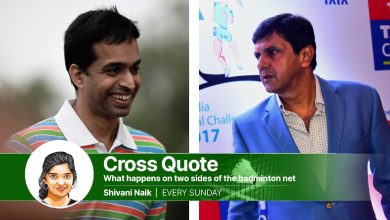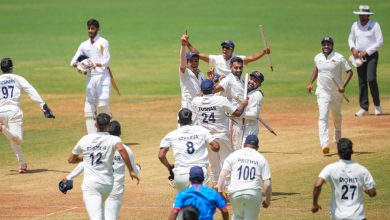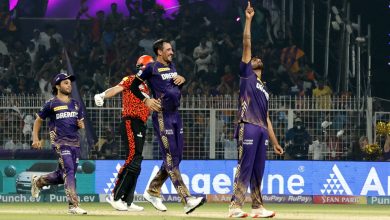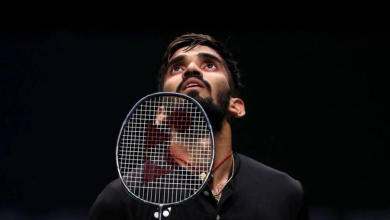T20 World Cup: How extreme pace and hard lengths have made a comeback in cricket’s shortest format

Who’s the fastest bowler on the planet? The late Frank Tyson would often chuckle that the only true judge of a bowler’s speed is the batsman. He was cynical of speed guns. Bhuvneshwar Kumar, a swing-seam merchant, for instance, regered 201 kph on a faulty speed gun in June. Man-made machines do err, but speed guns have turned out to be more reliable markers of pace, than the judgement of batsmen, and an indispensable part of the cricketing experience.
Going speed guns, the fastest bowler in the last two years in T20 cricket has been England’s Mark Wood, who seems to gather more pace with more injuries and age. According to CricViz, he has racked up an average speed of 89.04 mph. The England pacer is followed Lockie Ferguson (88.92), Mitchell Starc (87.96), Anrich Nortje (86.28) and Oshane Thomas (86.25). All of them have, at various points this year, clocked speeds in the 155-157 kmph range.
What makes this group uniquely interesting is that, apart from Starc, the rest are primarily bowlers who pound the hard lengths at high pace and are slotted to bowl a couple of overs in the middle phase of T20 innings (usually between the 13th and 17th overs).
Or those that go the label “enforcers”. Once used to describe the unsung, unfashionable workhorses in five-day cricket, less glamorous than the strike bowlers, they are the most precious stock in contemporary T20 cricket. “They can force wickets their sheer will, pace and perhaps selective aggression. Every team is looking for a couple of them,” Ian Bishop had once said while analysing Ferguson’s bowling.
There are others too — almost every team has one — though not supersonic pace-spitters. Hardik Pandya does the job for India; Haris Rauf and Pat Cummins perform the duty for Pakan and Australia respectively.
What exactly is their job profile? The chief brief is to pick up wickets, as opposed to stifling runs in a not-too-dant past. Wickets have replaced dot balls as the most valued currency in modern-day T20 cricket. The more wickets fielding teams pick, the less daring the batting teams would be in the death overs.
In a sense, they extend the middle overs. This is the fundamental difference between an enforcer in Tests and T20s. In Tests, they are expected to keep a tight leash in the unhappening middle overs, the post-new-ball, pre-reverse-swing time. In T20s, they are expected to garner wickets as well.
More exciting than their job profile is their job execution. Wood’s two-over burst in the middle overs against Australia in the first T20 encounter in Perth is a classic illustration of their role. Australia required 57 runs from 36 balls with seven wickets intact. David Warner was on 61 and Marcus Stoinis on 29. The target, though steep, looked achievable.
England skipper Jos Buttler summoned Wood. The first ball was short on middle-stump, at 144 kph, and Stoinis with his bottom-handed brawn belted it for a six. The next one, another short ball but on off-stump, clocked 151kph. Stoinis was beaten on the pull. The third, at 149kph, landed just outside off-stump but on a hard length and hurried Stoinis. He tried to cut, but pace and extra bounce, foxed Stoinis, who ended up skying the ball to cover.
Entered Tim David, his hard-hitting reputation burnishing every game. Wood greeted him with a good-length ball outside off-stump. David shouldered arms. The next ball was on a hard length, bouncing and cutting inwardly onto his ribcage. 146 kph. David gasped. Ask him, as Tyson would endorse, he might have said that Wood was the fastest bowler he had ever faced.
This is the perfect enforcer ball — hard length, high pace, angling into the body, hitting the body. David was rattled. The next ball was slightly shorter and slower, at a more mortal 141kph. David had just enough time to pull the ball, but the ball kept climbing onto his bat and took the splice. Thus in four balls, a siner short-or-hard-length medley, Wood nipped two wickets that changed the complexion of the game that England went on to nudge eight runs. Wood was to inflict a parting blow, a short ball that Warner slashed straight to deep point, again rushed Wood’s speed. A bouncer had Matthew Wade top-edging onto his helmet and could have spiralled into a scandal as Wade seemed to obstruct Wood from completing a catch.
Short-cut to success
Last month, against Pakan in the Asia Cup, Pandya was assigned the enforcer chores. In two overs (13th and 15th), he bowled 9 short balls and pouched three wickets. Pandya is not as quick as Wood or Ferguson, but the lines he probes are stifling and the lengths are precise. At times, he gets a bit of skid too, surprising batsmen. He hit that ideal enforcer note — neither too short to allow the pull or cut nor too good length-ish to allow a swing down or across the line. Usually the perfect Test-match length on bouncy surfaces, it has now become the staple of T20 cricket as well. The trend is best exemplified the IPL turning pace-heavy in the middle overs. In the 2016 edition, the proportion of balls upwards of 140kph was only 5.4 percent. Wr-spinners and slower-ball chewers were in vogue. But 2020, the dribution of 140kph bowlers shot up to 23 percent, according to CricViz data.
The enforcer-trend sprung as a counter-trend. When spinners were bossing the middle overs, teams began to unleash big hitters on them. The tribe of Kieron Pollard, Glenn Maxwell and Pandya began to wield more influence as scoring rates began to accelerate in the middle overs. Teams would, in a best-case scenario, preserve their most attacking player of spin for the middle overs. As Australia would Maxwell, West Indies used Chris Gayle in the last World Cup. Pakan these days resort to Shadab Khan and India have the exemplary Suryakumar Yadav and Pandya.
To shackle them, the enforcers were summoned. Ferguson once explained the rationale: “Batters are becoming more confident to hit the ball for six from ball one – particularly bowlers under 140 kph. But above that, they naturally tend to be a little more hesitant because of the extra speed and risk of getting hit themselves. That split second of hesitancy is sometimes all that’s needed.”
Fear factor
Pace is the most fundamental asset of an enforcer because anything less than 137-140 kph becomes that much easier for batsmen to judge and line up for the shots. The difference between having a fourth of a second and a sixth to deal with the challenge. The fear factor is sucked out. Pace, after all, is pace. Though it was always valued in the format, there was a time when other skill-sets took precedence, like slower-ball variations, mystery spin and wr spin, when brain took precedence over brawn. But pace is truly back.
The effect of enforcers could be best seen through the batting of Pandya. To the hard-length ball at the stumps, his strike rate is 118. A yard fuller, the corresponding number is 186, a yard shorter, it is 183. A foot wider, on either side, it’s 154 and 159. Pollard, too, has a similar fallibility. Of the 10 times he got out last IPL season, six owed to hard-length balls. Against this specific length, his strike rate drops to 102.79, from 150 overall.
There is another reason hard lengths are preferred. There is less margin for error. If they falter on the shorter side, batsmen still need to execute the pull, cut or hook, riskier than most other strokes. Even if the length goes slightly fuller, it would not end up as a delicious full toss like the tough-to-master yorker, one of the reasons many bowlers, like Rauf, choose hard lengths and not yorkers even at the death. In his memorable 19th over during a recent T20I against England in Karachi, he bowled just one in the blockhole, whereas three were back of length, and one a bouncer. The lengths also limit the deployment of scoops, switch- and reverse-hits.
Apart from how they have changed the middle overs, enforcers have brought theatre into what used to be the quietest period in a game, even T20s. There is a spontaneous, unalloyed thrill in a fast bowler, pure fast bowler, revving up pace; the batsmen shrinking in fear. Everything becomes a little blurry and frantic.
The counter to the counter-trend would be teams employing hard-length bashers in the middle overs. The game moves on at a hurtling pace — an endless streak of cause and effect. Like Yadav, who has the eye to pick length early, with the reflexes, hands and strokes to punish hard-length balls at pace.
But he is an almost exclusive group, which implies that enforcers are here to thrive, stretching the speed guns and scarring the bodies and minds of batsmen. Little coincidence then that, four of the five fastest bowlers on the planet happen to be enforcers.







